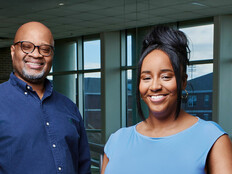Culinary Institute of Michigan Personalizes Learning with Streaming Video
Video production has come to the Culinary Institute of Michigan, where a leading-edge enterprise Internet Protocol TV system is reshaping education.
Similar to traditional TV, enterprise IPTV uses the same high-definition digital technologies for content creation and delivery. Functionally, the primary difference is distribution: enterprise TV is accessed by a limited audience while traditional TV broadcasts to the masses.
At the 460-student cooking school at Baker College, known as CIM, the adoption of enterprise IPTV evolved during construction of a new facility in the college's downtown Muskegon, Mich., location. Early on, CIM representatives visited other acclaimed culinary arts programs to gather best practices for incorporating video into the lab component of courses.
For the most part, other programs streamed general-purpose culinary videos on desktop computing devices. But CIM identified several technical and instructional deficiencies with such an approach.
First, commercial kitchens are notoriously poor computing environments. "We'd have to change keyboards and mice about once a month," says Brian Reagan, computer information systems supervisor at Baker. "That's considerable in terms of capital and IT staff costs."
Additionally, using general-purpose content created inefficiencies. "With a purchased video there may be only five minutes that you want to show for teaching," he says. "On the other hand, installing an in-house production system would provide our faculty with the ability to create the exact content they wanted, whether it's a two-minute demonstration or 10."
Instructionally, CIM also envisioned a more integrated approach than at other institutions, where half of the students in a lab session would watch a video while the other half practiced techniques.
"We wanted a system that would enhance live lab instruction rather than replace it," says Chef Robb White, dean of culinary arts at CIM. "And we wanted a system that would help differentiate us from other institutions, while also enhancing our ability to keep class sizes small and student-teacher ratios low."
Ultimately, CIM decided to pursue a hybrid instructional model that combines live instruction with on-demand video learning.
The Ingredients
To assemble the envisioned system, a journey of discovery began. "The IPTV project was exciting but also extremely challenging because the technology was totally new to us," Reagan says. "We knew what we wanted for an end product, but we didn't know all the pieces in between or how they all fit together."
In anticipation of adopting a known enterprise IPTV provider, CIM completed the necessary infrastructure in the new building. This included the cabling and three Cisco Catalyst switches: a 3750, 3560 and 2960G. A fiber communications link back to Baker's primary Muskegon campus (a distance of three miles) was also deployed to facilitate the data, voice and security requirements at CIM.
Then, as the new building neared completion in mid-2009, Cisco announced its new multifunction digital communications system, Cisco Cast. "The Cisco system could provide IPTV and digital signage using the same hardware," Reagan says. "Just the software modules differed."
Baker had already deployed Cisco-enabled digital signage at the college's main data center on its Flint campus. From the data center, digital signage messages broadcast on terminals located throughout the college's 16 locations.
Leveraging the deployed Cisco Digital Media Systems Server for IPTV became a no-brainer. "Using Cisco for IPTV as well as digital signage allowed us to kill two birds with one stone," Reagan says.
During the first six months of 2010, Cisco engineers planned and installed the IPTV system. Forming the software core is Cisco's Digital Media Manager along with the Cast and Digital Signs modules.
Additionally, each of CIM's eight kitchens received an LG large-format display monitor, a Cisco Digital Media Player and a Cisco Protective Case Mount to hold the player. A waterproof Cisco Digital Media Player Remote Control lets users select available videos from a menu.
For content creation, a demonstration kitchen doubles as a TV production studio with three high-definition cameras, studio lighting and other technologies for video capture, editing and storage.

Photo: Andy Wakeman
"The result is a technology marvel involving multiple solution providers as well as several vendors and numerous products," Reagan says.
The Recipe
"Everyone who visits is impressed beyond belief," Reagan says. "This makes our CIM unique. And, from an IT perspective, it's all effectively maintenance-free."
Functionally, video demonstrations get posted on Baker's course management system shortly before instructors cover the material during a lab. Students then review the videos in advance of the lab session. This lets CIM eliminate live demonstrations, which streamlines and individualizes the curriculum.
"Since some students need to see a skill a couple of times and some need to see it half a dozen, the on-demand demos simultaneously personalize instruction while also preparing students for the next lab session," White says.
With students coming to labs prepared, instructors spend more one-on-one time with each student.
Consequently, learning accelerates. "We're teaching more advanced techniques earlier in the curriculum," White says. "And because students start practicing techniques sooner, they become more refined at them."
For students, the benefits are off the charts.
"With live demos, you have to look over another student's shoulder," says Heather Karr, a CIM sophomore who started at Baker before the Cisco Cast deployment. "With a video, you can zoom in to see exactly what an instructor's hands are doing, and you can repeat sections as many times as needed."
For Karr, who is dyslexic, the new system also reduces learning gaps. "Reading is really difficult for me," she acknowledges. "I learn much faster and more thoroughly with the videos than before. And my retention is better."
Karr also points out that book learning has its limits. "When you're reading a book about a culinary technique, you're trying to interpret the words and visualize in your head," she says. "And in the photos, you see only a portion of each step."
Videos also reveal subtle nuances, Karr adds. "All of the chefs have different ways of doing things, which you can see on a video but not in a book."
Junior Jordan Freeze agrees: "Before, we'd watch a chicken fabrication demo once. Then, by the time we could do it ourselves in the lab, we'd forgotten some of the steps."
Plus, on-demand video availability in the labs reduces instructional downtime. "If you have a question and your instructor is busy with another student, you just bring up the demo on the lab's monitor and watch the steps you need to review," Freeze says.
Ready for Service
For the CIM faculty, Cisco Cast has created more one-on-one time with students, says Chef Justin Kinziger, a CIM instructor. "It allows me to build a better relationship with each one of them," he says. "This enables me to personalize their learning beyond what was possible before."
The new instructional model also addresses student confidence in a fresh way, Kinziger says. "During live group demos, some students are afraid to ask questions. Video demos help overcome this challenge."
And as one of three instructors who create content, Kinziger says the system even boosts instructional quality because the creation process provides useful insights.
"The system is definitely helping our curriculum evolve," he says. "Viewing and editing the camera footage teaches us about how we deliver the material – verbally and nonverbally – and provides feedback on how to improve."
It's a similar story for Greg Wade, a food and beverage instructor at CIM. "Video demos enhance my ability to get the learning message across," he says. "That alone enhances the educational experience for my students and for me professionally."
4 to 5
The times students typically replay an instructional video prior to attending a related laboratory session at CIM
Not surprisingly, the instructors look forward to future curricular possibilities enabled by the system. "For example, in our existing Bar and Beverage curriculum we make beer once," Wade says. "I can foresee videos showing how to create the whole spectrum of beer varieties – from pale ale to dark stout."
Kinziger and Wade also note opportunities for capturing guest lectures that CIM hosts for the local chapter of the American Culinary Federation. "We could incorporate those demos into the curriculum and make them accessible to the community," Wade says.
Kinziger even pictures videos showing the real-world consequences of common mistakes. For instance, CIM currently uses a video to depict the flambé technique for Bananas Foster. Students watch it numerous times before trying it themselves.
"In the future, we could also use video to show what can go wrong," he says. "If a preparation mistake causes the sprinkler system to go off in your restaurant, dousing all your guests and their meals, it really becomes a teachable moment."
Taking It to the Streets
Adopting Cisco's IPTV system isn't just transforming curriculum internally at Baker College's Culinary Institute of Michigan, it's also providing unique opportunities outside the confines of the college.
Ideas for producing demonstration videos accessible to the world community range from supporting other educational institutions to aiding the general public.
"For schools that can't afford what we've done, we could create demos for them," says Chef Robb White, dean of culinary arts at CIM. "And for the public we could really help with holiday meals."
"Thanksgiving is just one example," he says. "We receive so many calls – it would be great to post video demos to assist home cooks with making their special gatherings a success."








